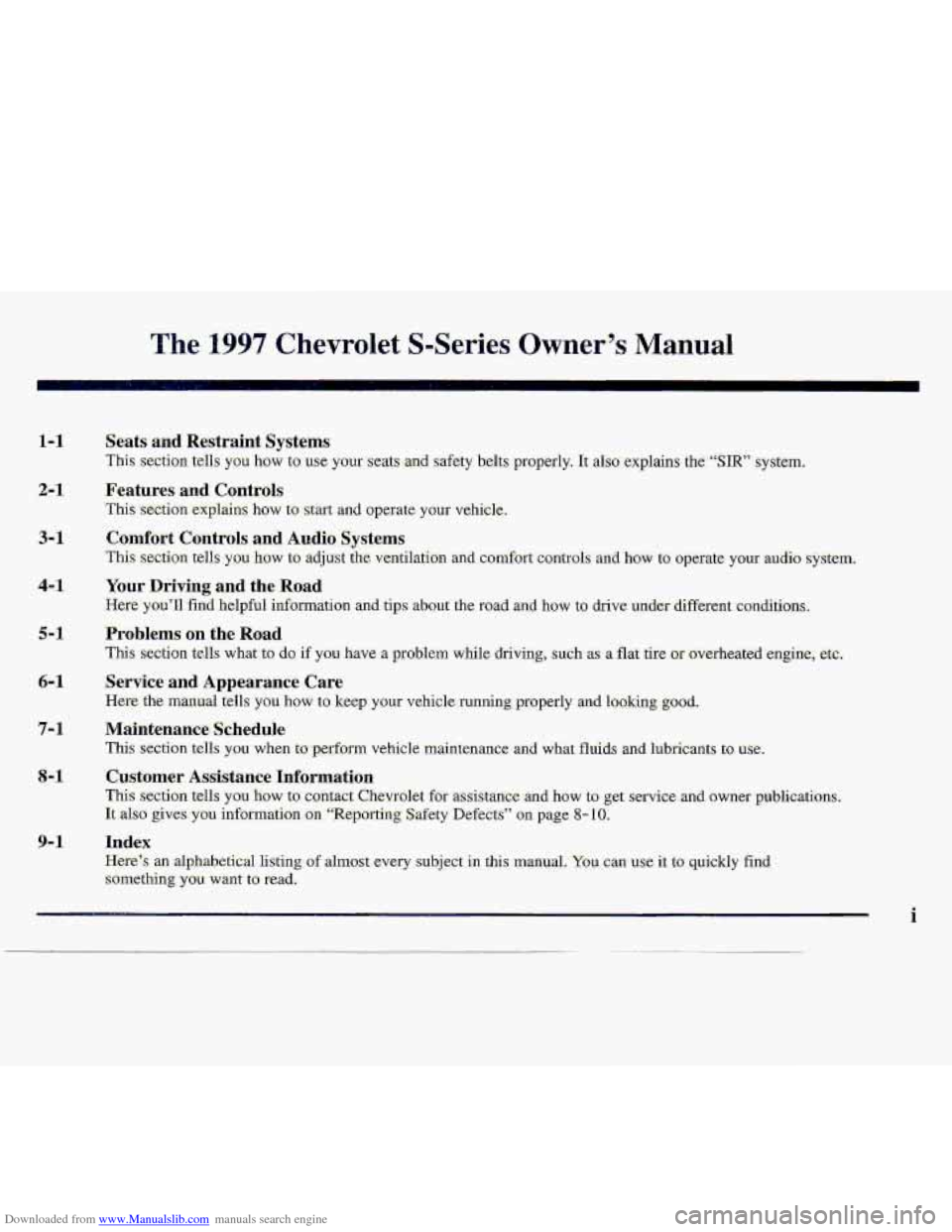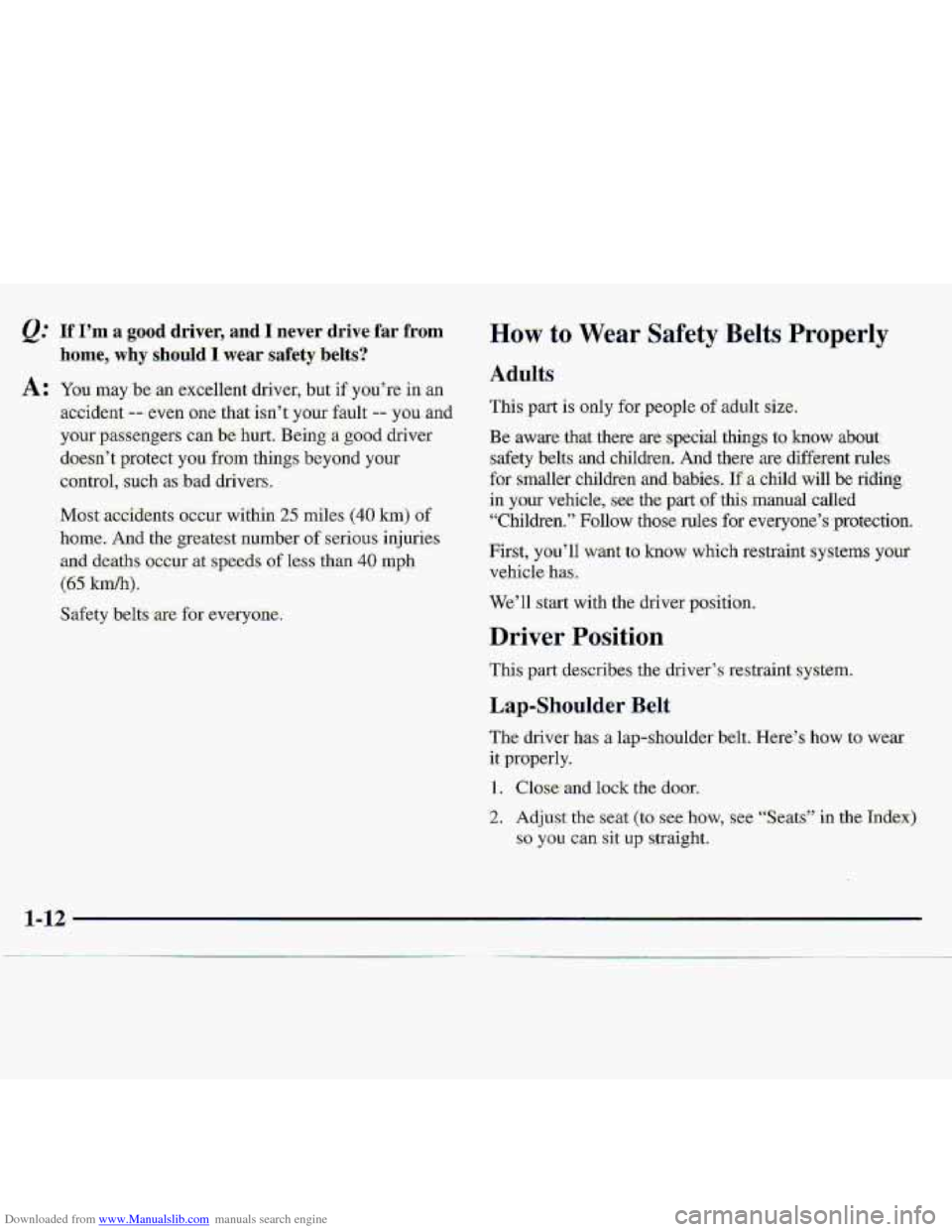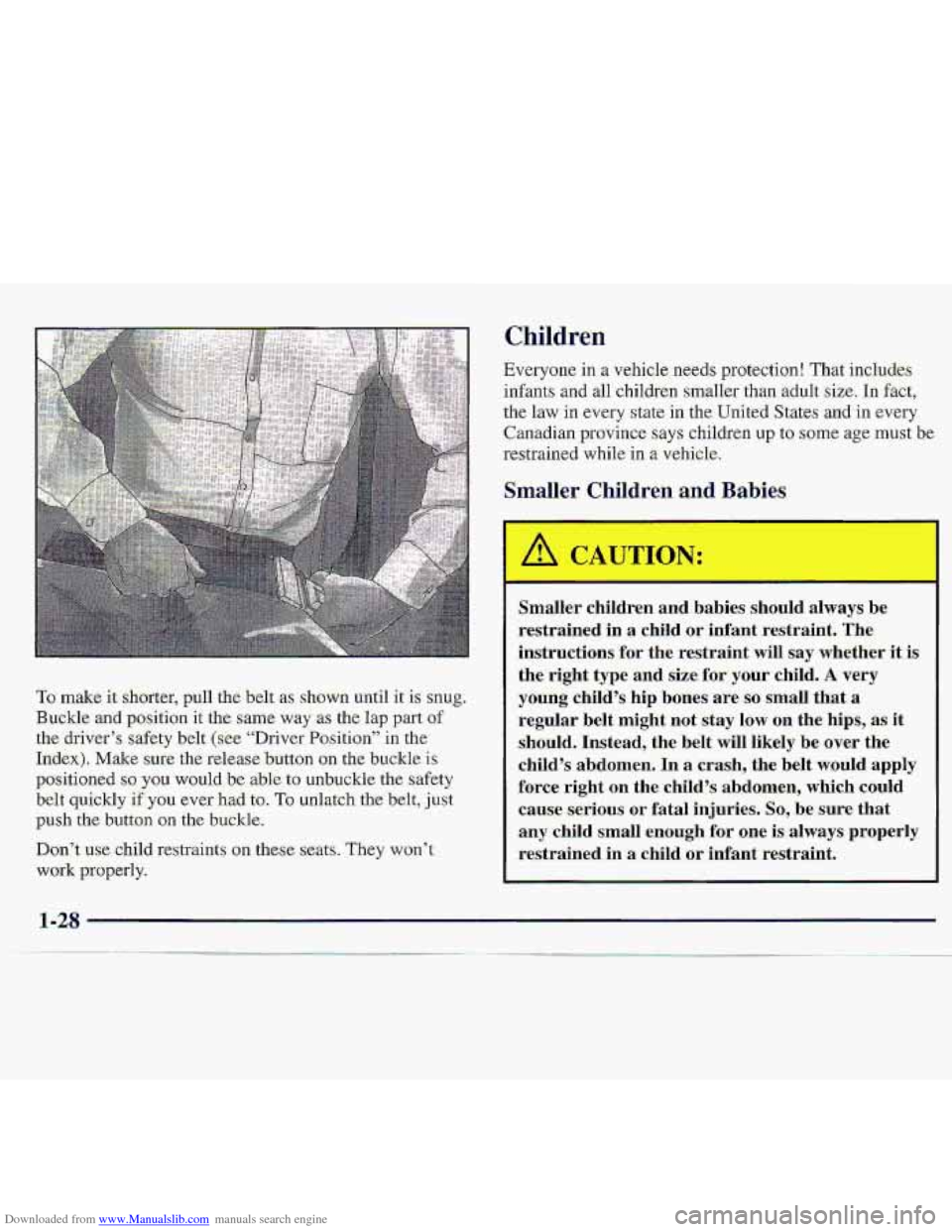Page 2 of 402

Downloaded from www.Manualslib.com manuals search engine The 1997 Chevrslet S-Series Owner’s Manual
1,- 1 Seats and Restraint Systems
This section tells you how to use your ‘seats-and s;afety belts properly. It also explains the:“SIB” system.
2-1
3-1
4-1
Features and Controls
This section.expl&s how to start and operate your vehicle.
C.omfOrt Contrals and Audio Systems
This sectiun tells you -how to adjust the venti-lation and cordfort c trols an&how 6 @Crate your audio system.
Your Driving and the Road
.He?& you’ll findhelpful information and tip.s about .the road ami how to drive underdifferent c:onditions.
511.
6-1
8-1
9- 1
Problems on the Road
This scctign tells what.to do. if you have a problem while driving, such as a flat tire or o-verheatd engine, etc.
Service and Appearance Care
Here the manual tells yon how to keep your vehic-le runriing prgperly and 1o.oking;go.od.
Maintenance- Schedule
This section tells you when toperform vehicle maintenance and what fluids and lubficants to use.
Customer Assistance Information
This sectim tells y0.u how to contact Chemolet for assistaxe and how to get s-ervice arid. owner publications.,
It alS0 @VeS YOU information on “Reporting Safety Defects” on page 8- 10.
Index
Here’s an alphabetical listing of.almost every subject in this manual: You can use it to quickly Wna,
something you want to read.
i
Page 8 of 402
Downloaded from www.Manualslib.com manuals search engine Section 1 Seats and Restraint Systems
Here you’ll find information about the seats in your vehicle and how to use your safety belts properly. You can also
learn about some
things you should not do with air bags and safety belts.
1-2
1-7
1-11
1-12
1-12 1-19
1-25
1-25 Seats
and Seat Controls
Safety Belts: They’re for Everyone
Here Are Questions Many People
Ask About
S.afety Belts
-- and the Answers
How
to Wear Safety Belts Properly
Driver Position
S.upplemental Matable Restraint
(SIR)
System
Safety Belt
Use During Pregnancy
Right Front Passenger Position 1-25
1-27
1-2.8
1-30
1-34
1-37
1-37
1-38 Center Passenger
P.osition
Rear Seat Passengers
(Extended Cab
Jump Seats)
Children
Child
Restraints
Larger Children Safety Belt Extender
Checking Your Restraint Systems
Replacing Restraint System Parts After
a Crash
1-1
Page 9 of 402
Downloaded from www.Manualslib.com manuals search engine Seats and Seat Controls
This; section tdls you about the seats -- how to adjust
them,
and fold them up- and down.
For vehicles without easy
Manual Front Seat
I
You can lose control of the vehicle if you try to
adjust
.a manual .driver’s seat while the vehicle is
moving. The- sudden movement could startle- and
confuse you, or make you push a pedal when you
don’t want to. Adjust the driver’s seat only when
the vehicle is not moving.
entry seats, move the lever
under the front of the seat
toward the driver’s door to
unlock it. Slide the seat to
where. you want it.
Then release the lever and
try to move the seat with
your body to make sure the
seat is locked into place.
For vehicles with-easy entry
seats, move the lever under
the. front
of the seat up to-
unlock
it. Slide the seat to
where you want it.,
Then release the lever and
try to move the seat with
your body to make sure the
seat is locked inTo place. .. . ..
1-2
Page 10 of 402
Downloaded from www.Manualslib.com manuals search engine Manual Lumbar Support (Option)
If you have this feature,
there
will be a knob on the
outside bf the driver and
passenger
bucket seats.
Reclining Seatbacks
(Bucket Seats or 60/40 Bench)
To adjust the front seatback,
lift the lever
on the outer I
side of the seat. I
I
I I
Turn the knob counterclockwise to increase lumbar
support
and clockwise to decrease lumbar support. Release the lever to lock the seatback where you want it.
Pull up
on the lever and the seat will go to an i
upright position. I I
Page 14 of 402

Downloaded from www.Manualslib.com manuals search engine Safety Bellts: They’re fo.r Ev.e-r,yone
This part of the manual tells you how to use safety belts
properly. It also tells you some things you should not do
with safety belts.
And it explains the Supplemental Matable Restrsnt (SIR),
or air bag system.
1 CAUTION: I
A CAUTION:
Don’t. let anyone ride where he or sne can’t wear
a safety belt properly. If you are in a crash and
you’re not wearing
a safety belt,, yo.ur injuries
can be much worse. You can hit things inside the
vehicle
or be ej.ected from it, You can be seriously
injured or killed.
In the same crash, you might
not he if you are buckled up. Always fasten your
safety belt, and check that
your passengers’ belts
are fastened properly too.
It is extremely dangerous to ride in a cargo area,
inside or ontside of a’ vehicle.. In a ~ollision,
people riding .in- these areas are more likely30
be
seriously injured or killed. Do not allow people
to ride in any area of your vehicle that is not
equipped with seats and .safety belts. Be sure
everyone
in your vehicle is in a seat and using~a
safeiy belt properly.
Page 19 of 402

Downloaded from www.Manualslib.com manuals search engine If I?rn a good driver, and I never drive far from
hame, why should I wear safety belts?
A: You may be an excellent driver, but if you’,re in an
accident
---even one that isn’t.your fault -- you and
your
passefigers can be hurt. Being a: gciod.driver
, d9esn”t prqtect you. from things beyond your
cantrd, such mbad drivem
Most accidents
occur within 25 miles (40 km) of
home. And the g:reatest number of serious injuries
and deaths occur
at speeds of less than 40 mph
(65 Wh).
Ho.w to Wear Safety Belts ‘Properly
Adults
This part is only for people of adult size.
Be aware .that there
are special things to know about
safety belts
and children. And there are different rules
for smaller children
and babies. If a.child will be ridag:
.in your vehicle,
see the part of this: m,anual called
“Children.” Follow those
rules for everyone’s protection.
First, you’ll
want to know which restraint systems your
vehde- has:.
We’ll
start with the driver positioa. Safety b.elts are for everyone.
Driver Position
This partdescribes the driver’s restraint system.
Lap-Sho.uld.er. B.elt
‘The driver has a lap-should€ - relt, Her( ho.w to wear
it properly.
I.. Close and lock the door.
2. Adjust the seat (to see how, see ‘Seats” in the Index)
so you c.an sit up straight.
1-12
Page 34 of 402
Downloaded from www.Manualslib.com manuals search engine Rear .Seat Passengers
(Extended Cab Jump .Seats)
Lap Belt
These a~e resave seating. positions equipped with lap belts.
only. (If your extended cab pickup has the optional side
axes-s. panel, there’s only one reserve seating position.)
It’s very i-mportant for rear seat passerigers to buckle-up!
Accident statistics show thatunbelted people in the rear
seat are huft-moxe often in crashes than those who are
wearing safety belts.
Rear passengers who- aren’t %ifety belted can be thrown
om. of the vehicle in a crash. And they can strike others
in the vehicle who afe:waring safety belts.
Each jwap seat has a lap belt with no retractor. To. make
the belt
longer; tih-the latch plate n little and pull the belt.
1-27
Page 35 of 402

Downloaded from www.Manualslib.com manuals search engine Childr 1
To make it shorter, pull the belt as shdwn until it is snug,.
Buckle and position it the same way as thelap pxrt of
,,the driver’s safety bdt (see “Driver Position” in the
,Index).
Make sure the: release button on the buckle. is
positioned so you would Ine .able to unbuckle the safety
belt quickly
if you ever had to. To unlatch the be:lt, just
push the button on the buckle.
Don’t use child restraints on these seats. They won’t
work properly. Everyone
m a
vehic1.e needs protection! That includes
infants
and all children smaller than adult size. In fact,
the
law in every state in the United States and--in every
Canadian province says children up to some age must
be
restrained while in a vehicle.
Smaller Children and Babie-s
Smaller children and babies s.hould always be
.restrained in
a child or infant restraint. The
instructions for
the restraint will say whether it is
.the right type
and size for your child. A very
young child’s hip
bones are so small that a
regular belt might not stay low on the hips, as it
.should. Instead, the belt will likely be over the
child’s abd,omen. In
a crash, the belt would apply
.force right on the child’s abdomen, which could cause serious or fatal injuries.
So, be sure that
any child small enough
for one is always properly
restrained in
a child or infant restraint.
1-28